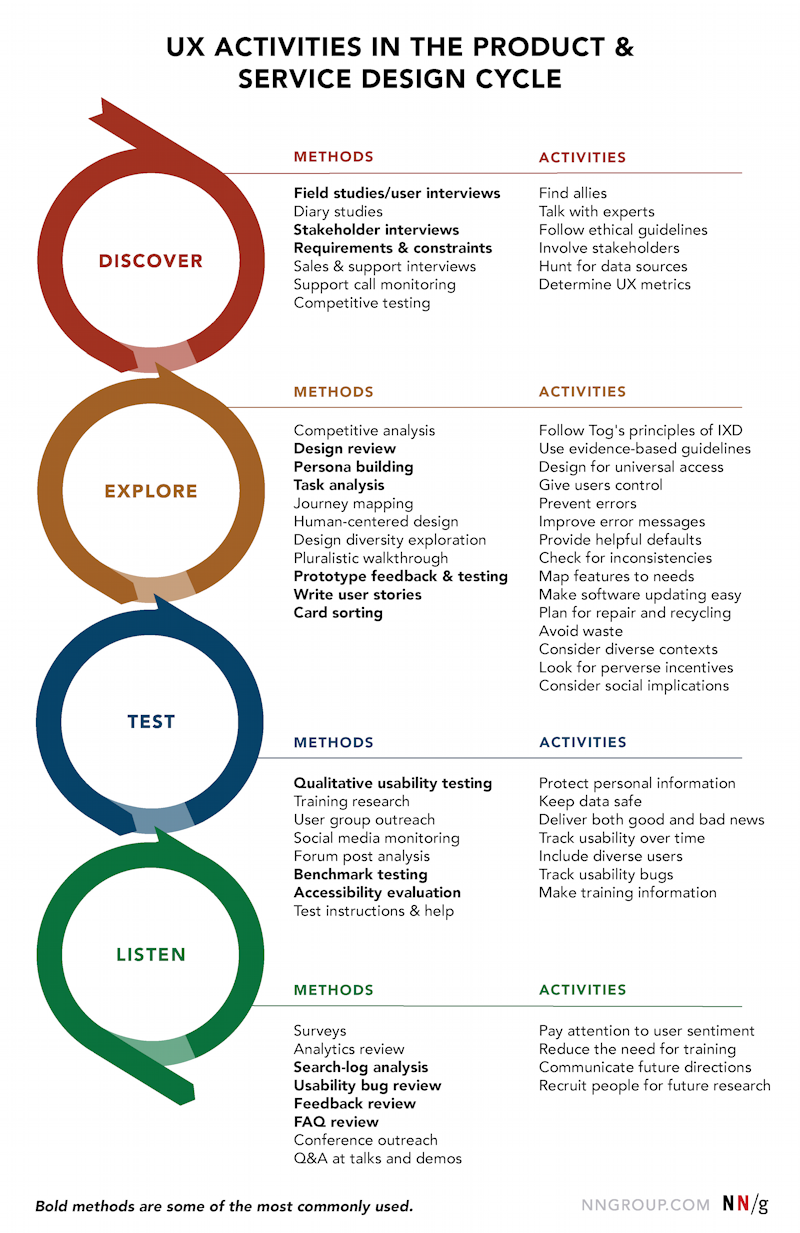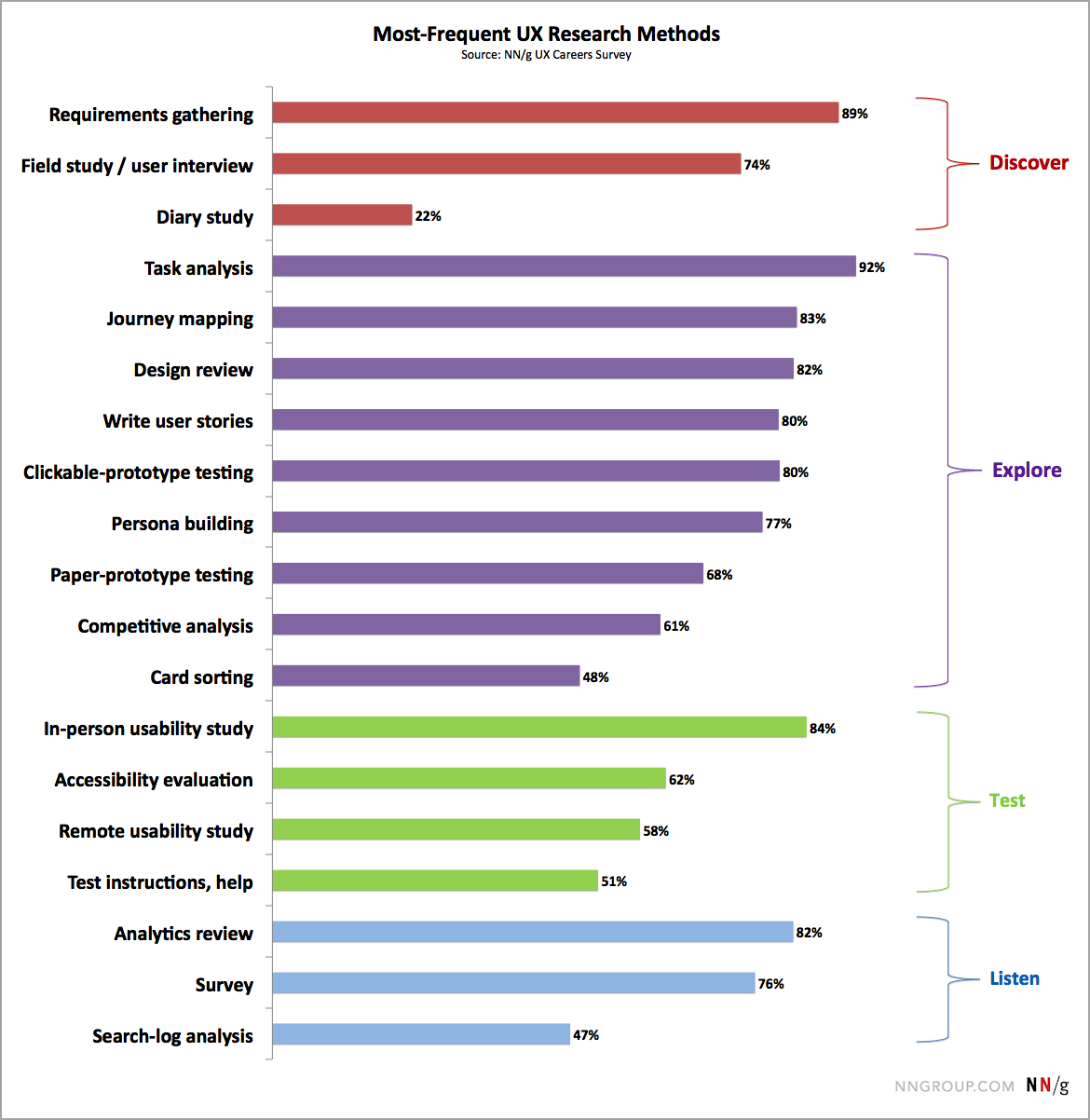Great UX journeys begin with great user research. User research keeps people at the center of the design process and products. It is meant to inspire your design, to analyze your solutions and to evaluate your impact.
What Is User Research?
Putting Users in UX: Research Methods For Strategy
So, user research comes into play when we set out to understand user’s needs, behaviors, experience, and motivations by way of qualitative and quantitative methods to conduct the process of solving user’s problems. If we talk of quantitative research tools, surveys and formal experiments are used so that user behavior is studied in a manner that can be quantified and taken for statistical analysis.

In qualitative research tools, interviews and to some extent, usability tests do the deed as it involves more exploration and detailed understanding of the experiences and day-to-day lives of different users or user groups.
| Top UX Research Methods | |
| Discover | • Field study • Diary study • User interview • Stakeholder interview • Requirements constraints gathering |
| Explore | • Competitive analysis • Design review • Persona building • Task analysis • Journey mapping • Prototype feedback testing (clickable or paper prototypes) • Write user stories • Card sorting |
| Test | • Qualitative usability testing (in-person or remote) • Benchmark testing • Accessibility evaluation |
| Listen | • Survey • Analytics review • Search-log analysis • Usability-bug review • Frequently-asked-questions (FAQ) review |
Then deciding where to start or what to focus on first, use some of these top UX methods. Some methods may be more appropriate than others, depending on time constraints, system maturity, type of product or service, and the current top concerns. It’s a good idea to use different or alternating methods for each product cycle because they are aimed at different goals and types of insight. The chart below shows how often UX practitioners reported engaging in these methods in our survey on UX careers.
 The most frequent methods used by UX professionals, from our free UX Careers survey report. Percentages
refer to the proportion of respondents who said they use each method at least every year or two.
The most frequent methods used by UX professionals, from our free UX Careers survey report. Percentages
refer to the proportion of respondents who said they use each method at least every year or two.
Some designers tend to overlook user research; below are three good reasons why designers must include user research-
Apt Designs
The most basic reason for conducting user research is that it’s the sole method to understand the users of your design. If you are well versed with your users only then you can create designs that are relevant for them. If you fail to know your users, you have no source of knowing if your design is apt or not.
A design that is irrelevant to its target audience is a mere failure. When it comes to design thinking, the first and the foremost step is to empathize with your users. And user research clearly fits the bill.
How To Conduct User Research?
Taking interviews and observations of people in the environment where they will be experiencing your design is a popular method of doing this type of user research. Such research is kept at the start to pilot an overall direction of the project for prospective customers and users.
To keep a track of the relevance of the project, always match your ideas with potential users on a regular basis. Talk to them about their views on your design and the way they will use it, or include them directly in the process, to make sure of your approach.
Easy And Delightful Designs
High usability is the key to perfect UX. People these days want products that are easy to learn and use. They expect the products to function the way they hope, not the way they are. If the user experience is not satisfactory, people might shift to another product.
The first secret of great design | Tony Fadell
Unless you are in a zone of zero competition, a high level of usability is required to achieve commercial success. Not to forget that your users will be completely swayed for creating such an amazing user experience.
Even if there are no alternative options for your users to switch to, products with enhanced usability will surely make processes quick, convenient and smooth.
Always keep the users’ perspective on priority when it comes to feature and functionality. Learn to separate the understandable from the not-so understandable.
Return on Investment (ROI)
Even though the importance of good design has gained exposure, still UX designers and researchers struggle to find resources in order to proceed with their work. Executives and shareholders doubt their investment in user research and UX design.
What Is The ROI of UX? and Why Some Organization’s Don’t Get It?
Considering the ‘look and feel’ concept of design, underestimating its value is not a big deal. It is seen that whenever resources suffer, UX is one of the first areas to be compromised as the effects are not immediately witnessed when you cut down on the development and other similar areas.
If you reduce in software development, ill effects can be seen in features or buggy software whereas cuts in UX, don’t backfire immediately until the product reaches your users. UX can only be valued if we show its importance.
If you succeed in projecting that the changes your design undergoes creates more sales, increases customers or adds to the efficiency of the work processes, you make a much stronger case of investing in UX. Your focus on customer experience should be consistent throughout the entire customer journey.
By now, one thing is clear- user research helps to unfold valuable insights about the user and their needs, emotions, feelings, and struggles. But what if you can’t approach your users? How will you perform UX research if there isn’t direct access to your users?
This could happen if you fall short of budget or span to run user tests, stakeholder interviews or card sorts. Yes, the very core of UX is shaken, i.e. talking to your users. In such a case, companies that are startups or have a limited digital footprint can function from mediums like forums or competitor reviews to understand the preferences of the users in the market.
For well-established firms, customer service logs and app reviews can benefit from getting users’ viewpoints about specific products. Without a doubt, first-hand research is the best way to be for user insights, but fortunately, there are other techniques to churn out qualitative data of your users which involves going beyond the regular lightweight guerrilla user testing options.
Here are some to widen your horizon-
Customer Service Logs
Customer service and help center departments come in direct contact with your users, resolving their grievances with the usability of your products. Being on front lines, they are aware of how users view the product and go ahead with its usage.
As user information is to be handled with care, the first task is to ask if service calls and contacts are being logged. If the answer is yes, inquire if it is possible to get hold of the records for user research purposes.
If there aren’t any logs or if they are inaccessible, find out whether a few short stakeholder interviews with the customer service team can be of any help. Study the interviews to find out the types of problems and complaints they commonly face.
Considering the working of customer service and the aim of help centers, there are greater chances of a large ratio of negative feedback. Still, these logs can furnish outstanding data.
On a specific note, the feedback can highlight policies and business practices that are degrading the user experience and just not that, but also the points at which they happen in the user journey. After all, your UX is much more than the design of your app and website.
App Reviews
When products have a mobile app feature, one should read the reviews present on the App Store or Google Play. The trick, with regards to user research, is to pay attention to the stuff that the user expresses as against the rating (i.e. one star to five stars).
Try to judge whether the user is simply dissatisfied or are they asking for value addition to the product. The review will surely tell if the user is delighted with some part of their experience of using the app or are they just brand worshippers.
Yes, reviews can be biased too, but remember that users tend to leave feedback as a result of an emotional reaction to the product. These emotionally triggered reviews – be it positive or negative- give a real picture, so make sure you gather all those reviews and get a peek into the wants of your users.
That said, a general reaction on the app, as a whole, might not be practical and worth acting upon.
You need to ask some questions – Is it about missing features that users want? Is the UI confusing for the users? Is the complaint about bugs or other issues that are making the app unstable? Is there a hidden feature that deserves to be in the front for the love it is receiving from people? Is the usage of app confusing and needs a tutorial on first open?
Further, don’t forget that the feedback on an iOS app might not necessarily be relevant to an Android app (or mobile web experience).
Industry Forums
Online forums like Reddit and 4Chan have undoubtedly questioned the authenticity of it all, but the truth is that there are many reliable online forums that serve as brilliant sources of information on how digital products function, how certain products and trends dominate as a whole in the market.
The research results might not be apparent but are easy to determine if you are on the lookout. If we look at the Apple TV apps section of Mac Rumors we can see that many users of the 4th generation Apple TV faced the issue with the YouTube app not disappearing video titles when a video is playing.
Also, a glimpse of the Delta Airlines thread on FlyerTalk reveals that people have posted questions from Economy Plus seating to the Delta and American Express credit cards. Evaluating such concerns could help Delta reframe the content strategy and information architecture of their mobile apps to deal with such questions upfront.
Many forums are irrelevant as they are pertaining to a particular industry. But there are numerous kinds which deal in varied industries. Ars Technica spans across almost any traditional tech product.
There is IGN for video games that talk anything and everything from game length to storyline to controls. Remember, not every forum unfolds detailed discussions on apps, companies or websites, but each proves to be a valuable source of knowledge on what inspires and satisfies consumers in a vertical market.
For nutrition and exercise, Bodybuilding.com’s BodySpace forum is a top online destination for users to discuss nutrition and exercise. Of course, not every forum offers in-depth discussions regarding specific apps, websites, or even companies, but each provides great sources of information about what motivates and interests consumers in that industry vertical.
Multiple topics in forums can be searched for companies or even particular product threads. Reddit (ignore the reputation) showcases growing, interactive communities of real users discussing on valuable topics. Quora gives a scholarly touch to the format with many users having strong subject matter points to substantiate their expertise.
Contact Form Emails
‘Contact Us’ forms and messages can prove to be a treasure house of information with direct data from your users. Of course, the first thing to notice is a complaint about any particular component of the website.
For instance, are users facing the issue with a feature or getting lost on a specific page on the site? On a broader scale, the forms themselves delve into areas of the user journey that are posing problems.
If a brand or company does not possess this option for accumulating site visitors’ opinions, it is best to include a contact form to boost development. Take note that if you keep a contact form on your site, there should be someone who should actively manage it and revert back to the users.
Competitive Reviews
Let’s say that your brand or product is new in the market and there isn’t sufficient data from the related sources to act upon. Now, what to do? Ask what your potential users think about the competitors.
If you are about to set up a car service, find out what users think about Lyft and Uber on the App Store. Want to enhance the performance of Jet? Go through reviews of Amazon Prime.
Take Away
Whatever is the case, there is no match of talking to your users, be it initial process in the form of stakeholder interviews or testing design iterations, but suppose that fails as an option, there is no justification for not approaching and collecting feedback from your users. Excellent UX design grounds on user insights, not on assumptions of standard practices or what is deduced from other products and industries. It all starts with the user.Go talk to your users and know their say. In platforms like Yelp! or Glassdoor or for that matter App Store Reviews, consumers are open to sharing their choices and reviews on businesses and different industry verticals. Just find out what they want. Remember, UX without users isn’t UX.
References
Empathic design: The most difficult simple approach to successful design
https://www.designorate.com/empathic-design-approach-to-successful-design/
Empathic design: Research strategies
https://www.ncbi.nlm.nih.gov/pmc/articles/PMC3575059/
When to use which user-experience research methods
https://www.nngroup.com/articles/which-ux-research-methods/
The biggest mistakes in user research and how to avoid them
https://www.uxmatters.com/mt/archives/2019/01/the-biggest-mistakes-in-user-research-part-1.php
10 User research myths and misconceptions
https://www.uxmatters.com/mt/archives/2015/11/10-user-research-myths-and-misconceptions.php
Skip user research unless you’re doing it right seriously
Further Resources
The Nielsen Norman Group has some fantastic articles on user research and UX Design more generally
https://www.nngroup.com/articles/
UK Government’s Service Manual on User research
https://www.gov.uk/service-manual/user-research
Thank you for reading! Hope this article has been insightful to you.



